Theory of Planned Behaviour
The theory of Planned Behavior (Ajzen, on 1985; on 1991) is an extension of the Theory of reasoned action. According to the author, the need for this new model results from limitations on behaviors on which people had little control. Ajzen added therefore a third element to his model, which according to him has an influence on a person’s intention to perform a behavior which he called perceived behavioral control.
Perceived behavioral control refers to readily available resources, skills, and opportunities as well as the person’s own perception towards the importance of achieving the results. The concept of Perceived Behavioral Control is close to the concept of self-efficacy of Bandura ( 1982 ).The latter explains that beliefs of an individual concerning his self-efficacy can have an influence on his choice of activities, his preparation for the activity and finally on the effort that he will exert during the activity in question. Therefore, if for example two individuals have the strong intention to learn a new language, the one who thinks that he will succeed in mastering it, is the one who will tend to persevere more than the other who doubts in his capacities (Ajzen, on 1991).
Ajzen’s model uses three variables (attitude, subjective norms, and perceived behavioral control) to demonstrate the direct influence that they have on the behavioral intention. The behavioral intention in turn influences the behavior. The figure below illustrates the links between the various variables:
Theory of Planned Behavior from Dillon and Morris (1996)
Taylor and Todd ( 1995 ) made a research on the theory of planned action in the specific context of new technologies. The authors used existing literature in order to identify antecedents of attitude, subjective norms and perception of control. Their results show that factors that determine attitude are perceived utility, perceived ease of use and compatibility. As for subjective norms, it seemed that the influence of peers and superiors had the greatest impact. Finally, self-efficacy and positive conditions such as available resources and technology are considered as factors determining the perceived behavioral control.
References
AJZEN, I. (1985). From intentions to actions: A theory of planned behavior. In J. Kuhl & J. Beckmann (Eds.), Action Control : From cognition to behavior (pp. 11- 39). Heidelberg: Springer.
AJZEN I. (1991). « The theory of planned behavior », Organizational Behavior and Human Decision Processes, vol. 50, pp. 179-211.
BANDURA A. (1982), Self-efficacy mechanism in human agency, American Psychologist 37 (2) 122-147.
